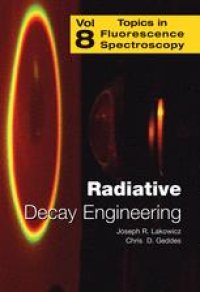
Ebook: Radiative Decay Engineering
- Tags: Analytical Chemistry, Biochemistry general, Biological Microscopy
- Series: Topics in Fluorescence Spectroscopy 8
- Year: 2005
- Publisher: Springer US
- Edition: 1
- Language: English
- pdf
During recent years our enthusiasm for Radiative Decay Engineering (RDE) has continually increased. Many of the early predictions have been confirmed experimentally. We see numerous applications for RDE in biotechnology, clinical assays and analytical chemistry. While implementation of RDE is relatively simple, understanding the principles of RDE is difficult. The concepts are widely distributed in the optics and chemical physics literature, often described in terms difficult to understand by biophysical scientists.
RDE includes chapters from the experts who have studied metal particle optics and fluorophore-metal interactions. This collection describes the fundamental principles for the widespread use of radiative decay engineering in the biological sciences and nanotechnology.
During recent years our enthusiasm for Radiative Decay Engineering (RDE) has continually increased. Many of the early predictions have been confirmed experimentally. We see numerous applications for RDE in biotechnology, clinical assays and analytical chemistry. While implementation of RDE is relatively simple, understanding the principles of RDE is difficult. The concepts are widely distributed in the optics and chemical physics literature, often described in terms difficult to understand by biophysical scientists.
RDE includes chapters from the experts who have studied metal particle optics and fluorophore-metal interactions. This collection describes the fundamental principles for the widespread use of radiative decay engineering in the biological sciences and nanotechnology.
During recent years our enthusiasm for Radiative Decay Engineering (RDE) has continually increased. Many of the early predictions have been confirmed experimentally. We see numerous applications for RDE in biotechnology, clinical assays and analytical chemistry. While implementation of RDE is relatively simple, understanding the principles of RDE is difficult. The concepts are widely distributed in the optics and chemical physics literature, often described in terms difficult to understand by biophysical scientists.
RDE includes chapters from the experts who have studied metal particle optics and fluorophore-metal interactions. This collection describes the fundamental principles for the widespread use of radiative decay engineering in the biological sciences and nanotechnology.
Content:
Front Matter....Pages i-xviii
Preparation of Noble Metal Colloids and Selected Structures....Pages 1-24
Near-Field Scanning Optical Microscopy: Alternative Modes of Use for NSOM Probes....Pages 25-46
Nanoparticles with Tunable Localized Surface Plasmon Resonances....Pages 47-99
Colloid Surface Chemistry....Pages 101-133
Bioanalytical Sensing Using Noble Metal Colloids....Pages 135-195
Theory of Fluorophore-Metallic Surface Interactions....Pages 197-221
Surface-Enhancement of Fluorescence Near Noble Metal Nanostructures....Pages 223-247
Time Resolved Fluorescence Measurements of Fluorophores Close to Metal Nanoparticles....Pages 249-273
Copper-Coated Self-Assembled Monolayers: Alkanethiols and Prospective Molecular Wires....Pages 275-303
Principles and Applications of Surface-Plasmon Field-Enhanced Fluorescence Techniques....Pages 305-332
Optically Detectable Colloidal Metal Labels: Properties, Methods, and Biomedical Applications....Pages 333-351
Noble Metal Nanoparticle Biosensors....Pages 353-380
Surface Plasmon-Coupled Emission: A New Method for Sensitive Fluorescence Detection....Pages 381-403
Radiative Decay Engineering (RDE)....Pages 405-448
Back Matter....Pages 449-457
During recent years our enthusiasm for Radiative Decay Engineering (RDE) has continually increased. Many of the early predictions have been confirmed experimentally. We see numerous applications for RDE in biotechnology, clinical assays and analytical chemistry. While implementation of RDE is relatively simple, understanding the principles of RDE is difficult. The concepts are widely distributed in the optics and chemical physics literature, often described in terms difficult to understand by biophysical scientists.
RDE includes chapters from the experts who have studied metal particle optics and fluorophore-metal interactions. This collection describes the fundamental principles for the widespread use of radiative decay engineering in the biological sciences and nanotechnology.
Content:
Front Matter....Pages i-xviii
Preparation of Noble Metal Colloids and Selected Structures....Pages 1-24
Near-Field Scanning Optical Microscopy: Alternative Modes of Use for NSOM Probes....Pages 25-46
Nanoparticles with Tunable Localized Surface Plasmon Resonances....Pages 47-99
Colloid Surface Chemistry....Pages 101-133
Bioanalytical Sensing Using Noble Metal Colloids....Pages 135-195
Theory of Fluorophore-Metallic Surface Interactions....Pages 197-221
Surface-Enhancement of Fluorescence Near Noble Metal Nanostructures....Pages 223-247
Time Resolved Fluorescence Measurements of Fluorophores Close to Metal Nanoparticles....Pages 249-273
Copper-Coated Self-Assembled Monolayers: Alkanethiols and Prospective Molecular Wires....Pages 275-303
Principles and Applications of Surface-Plasmon Field-Enhanced Fluorescence Techniques....Pages 305-332
Optically Detectable Colloidal Metal Labels: Properties, Methods, and Biomedical Applications....Pages 333-351
Noble Metal Nanoparticle Biosensors....Pages 353-380
Surface Plasmon-Coupled Emission: A New Method for Sensitive Fluorescence Detection....Pages 381-403
Radiative Decay Engineering (RDE)....Pages 405-448
Back Matter....Pages 449-457
....